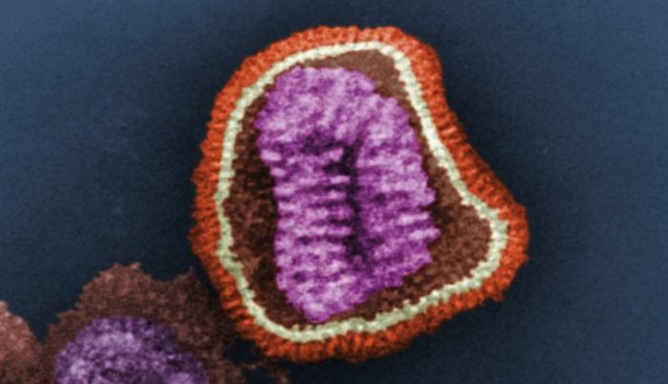
Explainer: What is a Virus?

This article was originally published at The Conversation. The publication contributed the article to Live Science's Expert Voices: Op-Ed & Insights.
It may seem like a fairly fundamental question, but there is still debate over whether viruses should be considered a form of life.
The diversity of viral infections is immense. Viruses cause everything from common cold (rhinoviruses) to Ebola and warts (papillomavirus); from HIV/AIDS to influenza and smallpox. Many viruses can cause cancer: the hepatitis B virus is a known cause of liver cancer, and some types of human papillomavirus cause cervical cancer.
Although viruses exhibit some of the characteristics of living organisms — they have genes, evolve by natural selection and create copies of themselves — most biologists argue they aren’t alive because they can’t replicate by themselves.
To say that viruses are small is an understatement. If the human genome were “War and Peace”, the average bacterium would have a genome of about a page or two. On this scale, the influenza virus is about two words; the smallest virus, circovirus, merely a letter or two.
Essentially, viruses are snippets of genetic code that hijack the mechanics of living cells to replicate themselves, escape the cell and spread (the “computer virus” analogy is apt). Even their envelope – the coating that many viruses have to protect their contents – is derived from the cells of their hosts.
Stopping viruses
Some viruses that cause human disease can be prevented from doing so — with varying degrees of success — through vaccines.

The origin of the word vaccine (from the Latin for “cow”) comes from Edward Jenner’s observation that milkmaids appeared to be immune from smallpox. From this came the idea that infection with a closely related but less dangerous virus could protect against serious disease.
It was subsequently found that even inactivated viruses (such as those in the rabies and polio vaccines) or parts of viruses (such as those in the hepatitis B and influenza vaccines) were able to stimulate the immune system to remember and protect from infection on subsequent exposure.
The best vaccines have even resulted in the eradication of diseases, such as smallpox and rinderpest. Hopefully, in the near future, polio and measles will also become illnesses of the past.
Compared with antibiotics for treating bacterial infection, which were developed in the 1940s, antiviral treatments are a much more recent development.
Most antiviral medication attempts to block one or more points in the viral replication cycle. Many antiviral medications used to treat HIV and herpes simplex (which causes cold sores), for instance, jam the replication mechanism itself.
Other antivirals interfere with the mechanism viruses use to enter or exit host cells (such as oseltamivir for influenza), while others stimulate the immune system to seek and destroy virally-infected cells (such as interferon for hepatitis C).
Mega-, mimi-, or TRUC?
Humans (or at least doctors) take a very anthropocentric view of the world, but viruses can infect all living organisms, even bacteria (bacteriophages). And they seem to be everywhere.

J Craig Venter, the biologist and entrepreneur who was one of the first to sequence the human genome (interestingly, his own), circumnavigated the world in his yacht and sampled seawater as he went. When his team examined the samples, they found an incredible diversity of new viruses, with about 10 million copies of viruses per millilitre of water.
The recent discovery of new very large viruses has also blurred the lines between what does and does not constitute life. In 2003, the Mimivirus was found inside an amoeba in a cooling tower in England. It was named the “microbe mimicking virus” as it was visible under a microscope and had a genome that rivalled small bacteria.
The current biggest virus record holder is the Pandoravirus, found in a pond in Melbourne. Its genome approaches the complexity of a small parasite.
These recent discoveries have prompted a reconsideration of the nature and classification of life. Didier Raoult, the French biologist who led the team that discovered Mimivirus, has even proposed reclassifying complex organisms such as giant viruses as “truc”. This is French for “stuff”, as well as being an acronym for “things resisting [un]complete classification” — in other words, the “too hard” basket.
Are the seawater viruses the soup from which we subsequently evolved? More research may yield answers to these and other interesting questions. Whatever the case, it is clear that these tiny genetic parasites will always be problems for us to contend with.
Allen Cheng receives funding from the National Health and Medical Research Council.
This article was originally published on The Conversation. Read the original article. The views expressed are those of the author and do not necessarily reflect the views of the publisher. This version of the article was originally published on Live Science.
Sign up for the Live Science daily newsletter now
Get the world’s most fascinating discoveries delivered straight to your inbox.

Allen Cheng is a specialist in infectious diseases and an epidemiologist. He is Professor/Director of Infectious Diseases at Monash Health and the School of Clinical Sciences at Monash University in Melbourne. He is involved in the treatment of patients with infectious diseases, and providing advice to governments on communicable diseases control. He is also involved in surveillance for influenza-related hospital admissions and in clinical trials.










